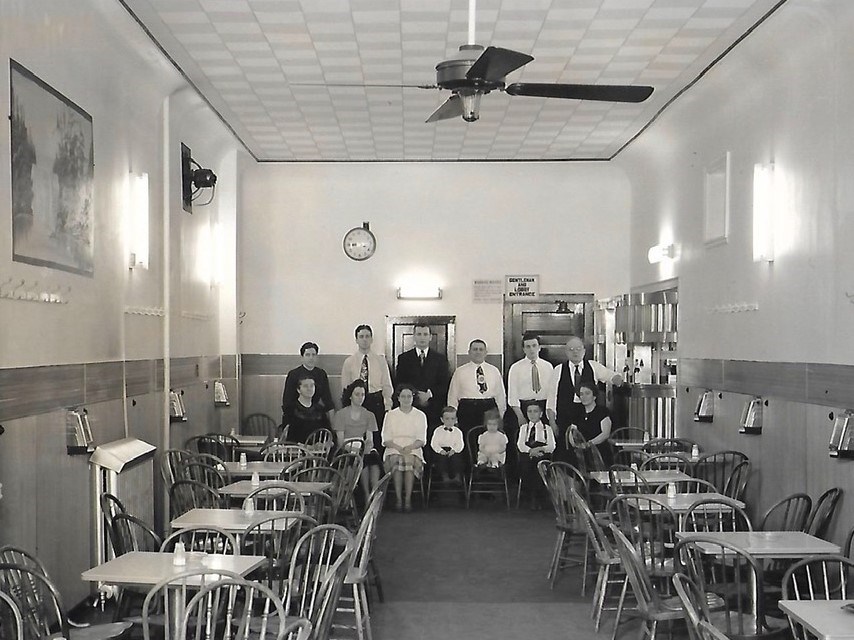From the archives of the Sault Ste. Marie Public Library:
Ontario has a long and complex history when it comes to alcohol consumption — and the gendered aspects are no exception.
In the 1930s, the concept of “mixed drinking” — women drinking in beer rooms with men — prompted outrage and concern from a public that feared it led to an increase in prostitution, sexually transmitted infections, and moral decline. In response, the Liquor Control Board began segregating establishments by gender.
As the Globe and Mail reported in 1937, these new rules “[required] all Ontario hotels with authorities to operate two separate and distinct beverage rooms — one for men only, and the other solely for women, except where attended by bonafide escorts.”
This applied not only to the public wishing to drink at an establishment but also to employees: for years, women were forbidden from serving alcohol at all, even if they owned the establishment.
In 1944, the restrictions loosened a bit, allowing women to work as waitresses, but only in the room for ladies and escorts, and only if the establishment applied for permission “and [submitted] a medical certificate... indicating that [the waitress was] free from disease.”
There were also strict requirements as to how these gendered beverage rooms were to be run.
As Maclean’s magazine reported in 1945, they could only be located in clubs, messes, and hotels — a hotel being a building with at least six bedrooms meant for “the travelling public” as well as food facilities. Both the men’s and women’s beverage rooms had to be “screened from public gaze.”
Intoxication was forbidden, as was music, games, entertainment, and drinking standing up — everyone had to be seated. While rules surrounding drinking changed over the next few decades, becoming somewhat more nebulous with different standards for restaurants, cocktail lounges, and taverns, gender segregation persisted.
In the late 60s, establishments were permitted to apply to allow women into men’s only rooms, and in the early 70s, establishments were permitted to apply to have mixed-gender drinking rooms if they so chose.
Locally, according to a 1971 Sault Star article, responses were mixed.
At least one hotel owner said that his patrons appreciated separate rooms: “Men in working clothes, office girls and housewives, say they like their own rooms. We have been told by husbands that they like the arrangement for the wives when unescorted.”
Others, however, quickly put in their application for a mixed space. Also, in 1971, women were officially allowed to serve alcohol in men’s drinking rooms — or, as the Sault Star proclaimed, “Females Invade Last Male Haven as Waitresses.”
There were concerns about the waitresses having “tender ears” that would impede men’s conversations with each other. However, many establishments reported that their waitresses were working out just fine.
And finally, in January 1976, the Liquor Licence Board of Ontario Act allowed men and women to be served in any licensed establishment. However, despite the change in legislation, a 1977 Sault Star article noted that hotels “unofficially” segregated by gender.
This took the form of signs on doors, labelling entrances for men and women/escorts — these signs could still legally stay up, even if they were unenforceable.
If a bar refused to serve someone based on gender, however, it could become a human rights issue. Two female Sault Star reporters decided to test this for themselves. The women went to the New American, entered through the men’s door, and endured whistles and jokes from the clientele inside.
A waitress informed them that they were in the wrong room — but clarified that it wouldn’t be illegal to stay.
Nevertheless, the women entering the men’s beverage room caused such a stir that the reporters said, “I was never so embarrassed in all my life... I’ll never do that again.”
A male Sault Star reporter had no such issue when he went to the ladies and escorts room at the New American for a drink — nor did he at the other bars around town he visited. However, at least one other hotel spokesman took issue with the new rules.
“We can’t keep them out but we do the best we can,” he said, before blaming the women’s lib movement for the change.
Nevertheless, a waitress from another establishment perhaps said it best when she referred to gender segregation of bars being a relic “from the olden days.”
Each week, the Sault Ste. Marie Public Library and its Archives provides SooToday readers with a glimpse of the city’s past.
Find out more of what the Public Library has to offer at www.ssmpl.ca and look for more Remember This? columns here
